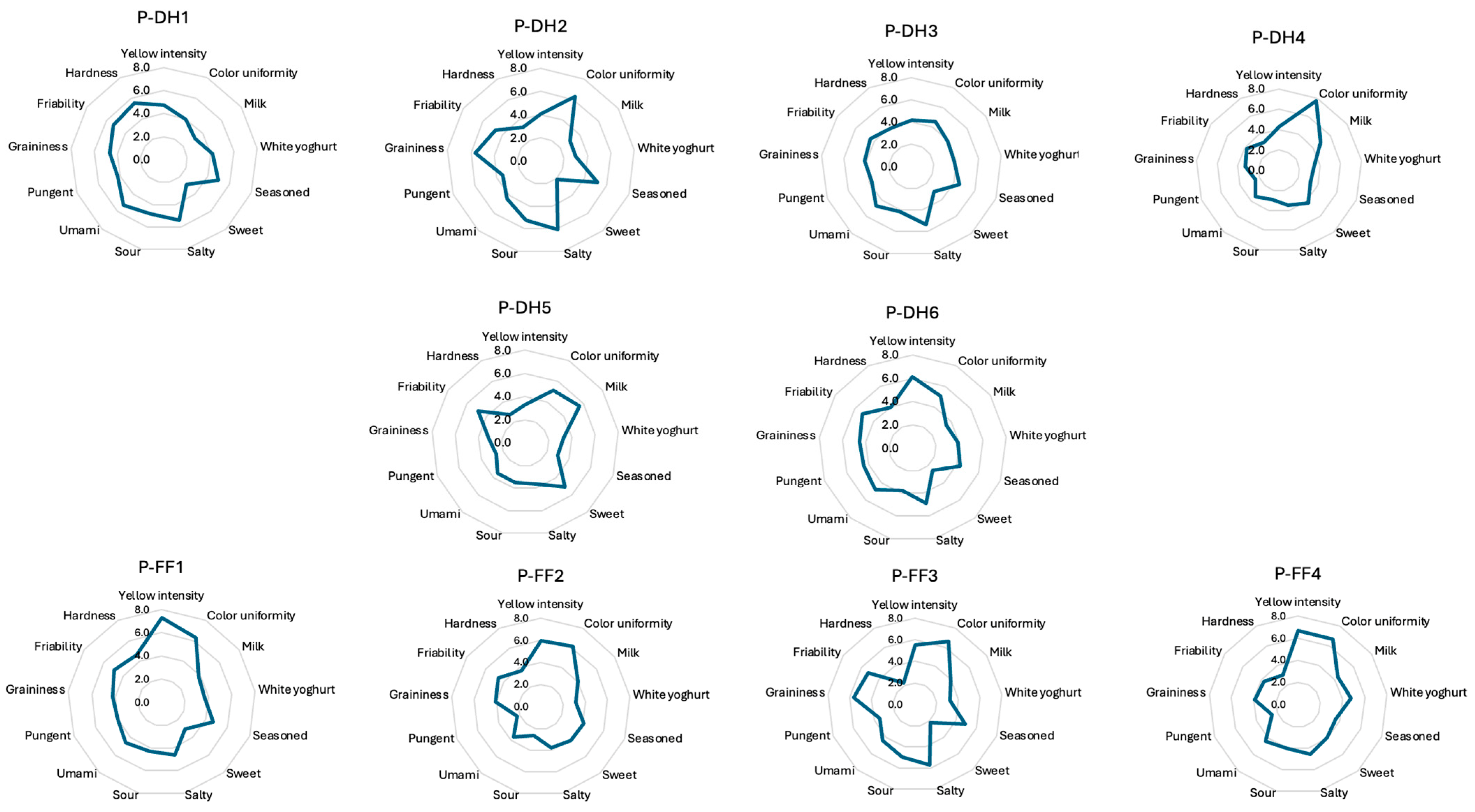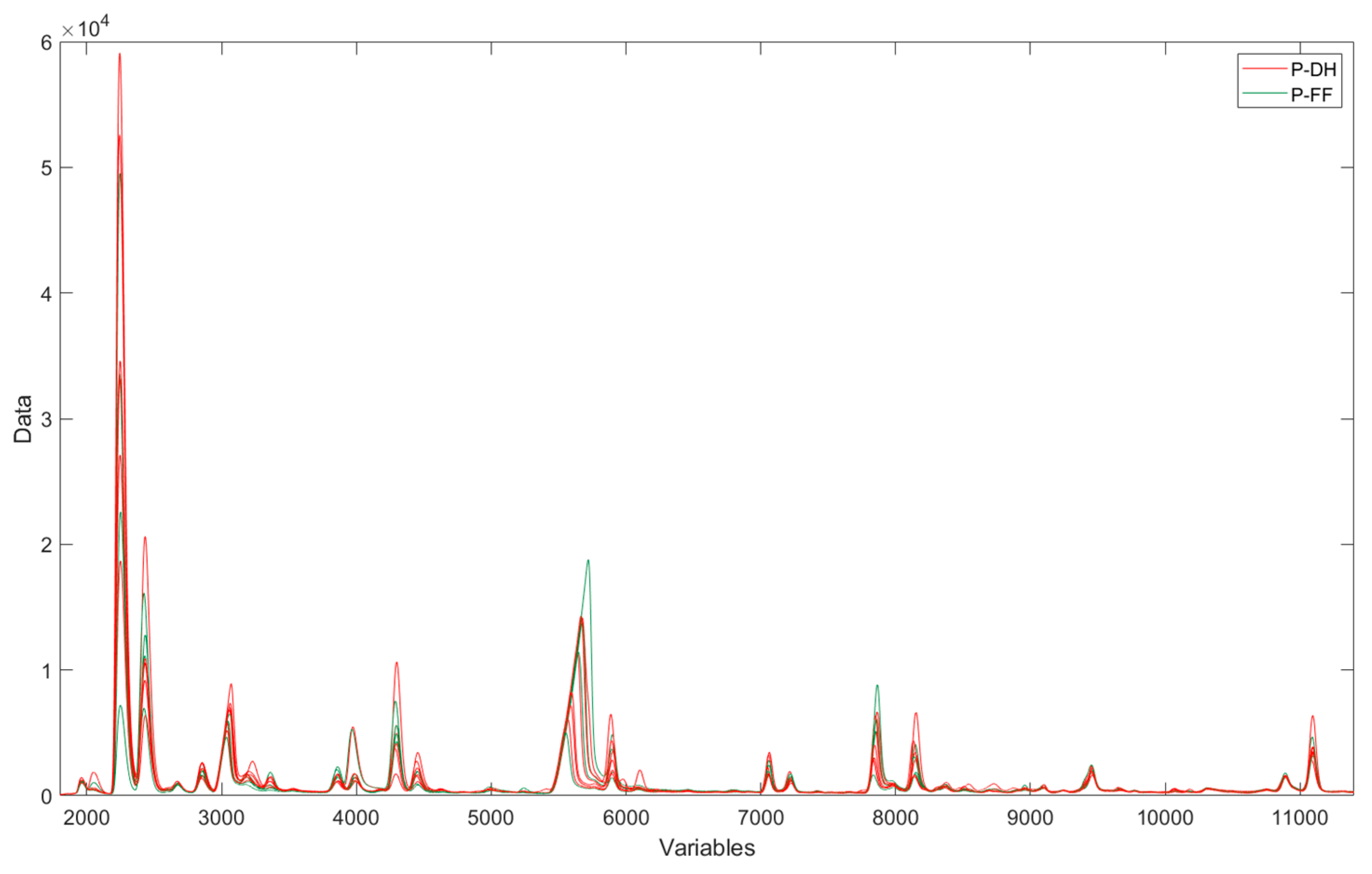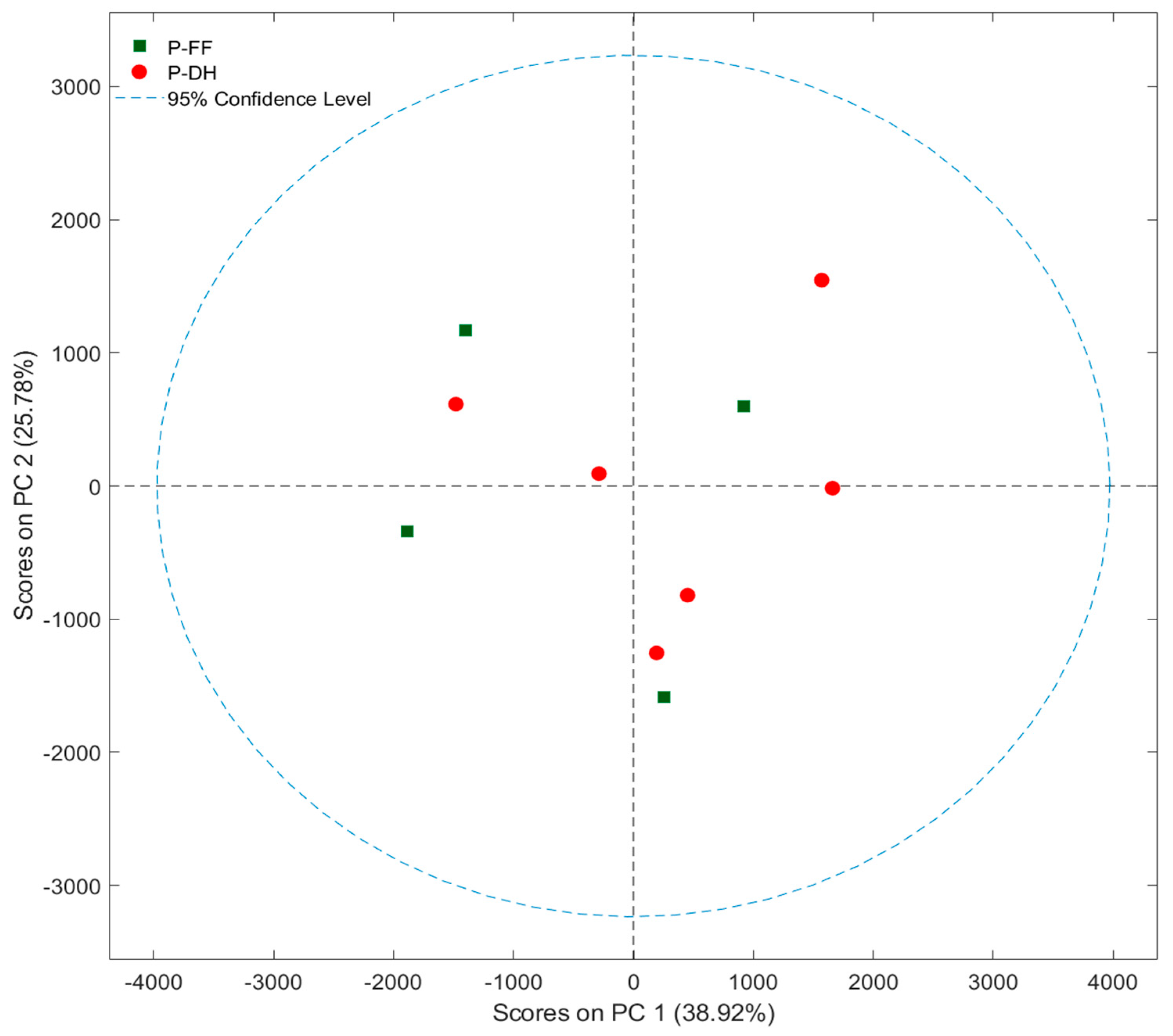Sensory and Instrumental Characterization of Parmigiano Reggiano Protected Designation of Origin Cheese Obtained from Milk of Cows Fed Fresh Herbage vs. Dry Hay †
Abstract
1. Introduction
2. Materials and Methods
2.1. Ethical Approval
2.2. Samples
2.3. Sensory Analysis
2.3.1. Panel Selection
2.3.2. Sensory Vocabulary
2.3.3. Evaluation Sheet/Procedure
2.3.4. Training Procedure
2.4. Image Analysis
2.5. Flash GC-FID Analysis of the Volatile Fraction
2.6. Data Analysis
3. Results
3.1. Sensory Analysis
3.2. Image Analysis
3.3. Flash GC-FID Analysis of the Volatile Fraction
4. Discussion
5. Conclusions
Author Contributions
Funding
Institutional Review Board Statement
Informed Consent Statement
Data Availability Statement
Acknowledgments
Conflicts of Interest
References
- Gagliano, M.A.; Tura, M.; Soglia, F.; Cevoli, C.; Sara, B.; Braschi, G.; Patrignani, F.; Bendini, A.; Petracci, M.; Gallina Toschi, T.; et al. Caratterizzazione sensoriale, strumentale e microbiologica di “Parmigiano Reggiano DOP” prodotto con latte da bovine alimentate con diete differenti. In Proceedings of the VIII Convegno Nazionale SISS, Alghero, Italy, 22–24 May 2024. [Google Scholar]
- Becchi, P.P.; Rocchetti, G.; Vezzulli, F.; Lambri, M.; Lucini, L. The integrated metabolomics and sensory analyses unravel the peculiarities of mountain grassland-based cheese production: The case of Parmigiano Reggiano PDO. Food Chem. 2023, 428, 136803. [Google Scholar] [CrossRef]
- Publication of an Application for Approval of a Minor Amendment in Accordance with the Second Subparagraph of Article 53 of Regulation (EU) No 1151/2012 of the European Parliament and of the Council on Quality Schemes for Agricultural Products and Foodstuffs, Single Document ‘Parmigiano Reggiano’ EU No: PDO-IT-02202—14.11.2016. Available online: https://eur-lex.europa.eu/legal-content/EN/TXT/PDF/?uri=CELEX:52018XC0413(01) (accessed on 20 January 2025).
- Guide for the Sensory Analysis of Parmigiano Reggiano, Parmigiano-Reggiano Cheese Consortium. Available online: https://www.parmigianoreggiano.com/it/prodotto-guida-analisi-sensoriale#2 (accessed on 20 January 2025).
- Mordenti, A.L.; Brogna, N.; Formigoni, A. The link between feeding dairy cows and Parmigiano-Reggiano cheese production area. Prof. Anim. Sci. 2017, 33, 520–529. [Google Scholar] [CrossRef]
- Manzocchi, E.; Martin, B.; Bord, C.; Verdier-Metz, I.; Bouchon, M.; De Marchi, M.; Constant, I.; Giller, K.; Kreuzer, M.; Berard, J.; et al. Feeding Cows with Hay, Silage, or Fresh Herbage on Pasture or Indoors Affects Sensory Properties and Chemical Composition of Milk and Cheese. J. Dairy Sci. 2021, 104, 5285–5302. [Google Scholar] [CrossRef] [PubMed]
- Alothman, M.; Hogan, S.A.; Hennessy, D.; Dillon, P.; Kilcawley, K.N.; O’Donovan, M.; Tobin, J.; Fenelon, M.A.; O’Callaghan, T.F. The “Grass-Fed” Milk Story: Understanding the Impact of Pasture Feeding on the Composition and Quality of Bovine Milk. Foods 2019, 8, 350. [Google Scholar] [CrossRef]
- Tura, M.; Gagliano, M.A.; Soglia, F.; Bendini, A.; Patrignani, F.; Petracci, M.; Gallina Toschi, T.; Valli, E. Consumer Perception and Liking of Parmigiano Reggiano Protected Designation of Origin (PDO) Cheese Produced with Milk from Cows Fed Fresh Forage vs. Dry Hay. Foods 2024, 13, 309. [Google Scholar] [CrossRef] [PubMed]
- Ianni, A.; Bennato, F.; Martino, C.; Grotta, L.; Martino, G. Volatile Flavor Compounds in Cheese as Affected by Ruminant Diet. Molecules 2020, 25, 461. [Google Scholar] [CrossRef]
- Balivo, A.; Masucci, F.; Parlato, S.; Serrapica, F.; Romano, R.; Di Francia, A.; Genovese, A. Can Hydroponic Forage Affect the Chemical and Sensory Properties of PDO Buffalo Mozzarella Cheese? Int. J. Dairy Technol. 2025, 78, e13147. [Google Scholar] [CrossRef]
- Hamilton, L.M.; Lahne, J. Fast and Automated Sensory Analysis: Using Natural Language Processing for Descriptive Lexicon Development. Food Qual. Prefer. 2020, 83, 103926. [Google Scholar] [CrossRef]
- Rabitti, N.S.; Cattaneo, C.; Appiani, M.; Proserpio, C.; Laureati, M. Describing the Sensory Complexity of Italian Wines: Application of the Rate-All-That-Apply (RATA) Method. Foods 2022, 11, 2417. [Google Scholar] [CrossRef]
- Abbatangelo, M.; Núñez-Carmona, E.; Sberveglieri, V.; Zappa, D.; Comini, E.; Sberveglieri, G. Application of a Novel S3 Nanowire Gas Sensor Device in Parallel with GC-MS for the Identification of Rind Percentage of Grated Parmigiano Reggiano. Sensors 2018, 18, 1617. [Google Scholar] [CrossRef]
- Sberveglieri, V. Validation of Parmigiano Reggiano Cheese Aroma Authenticity, Categorized through the Use of an Array of Semiconductors Nanowire Device (S3). Materials 2016, 9, 81. [Google Scholar] [CrossRef]
- Ferreira, M.M.; Marins-Gonçalves, L.; De Souza, D. An Integrative Review of Analytical Techniques Used in Food Authentication: A Detailed Description for Milk and Dairy Products. Food Chem. 2024, 457, 140206. [Google Scholar] [CrossRef]
- Bord, C.; Lenoir, L.; Benoit, J.; Guérinon, D.; Dechambre, G.; Chassard, C.; Coelho, C. Characterization of Cantal and Salers Protected Designation of Origin Cheeses Based on Sensory Analysis, Physicochemical Characteristics and Volatile Compounds. Appl. Sci. 2025, 15, 961. [Google Scholar] [CrossRef]
- Galli, B.D. Sustainability Implications and Relevance of Using Omics Sciences to Investigate Cheeses with Protected Designation of Origin. J. Sci. Food Agric. 2024, 104, 6388–6396. [Google Scholar] [CrossRef] [PubMed]
- Falih, M.A.; Altemimi, A.B.; Hamed Alkaisy, Q.; Awlqadr, F.H.; Abedelmaksoud, T.G.; Amjadi, S.; Hesarinejad, M.A. Enhancing Safety and Quality in the Global Cheese Industry: A Review of Innovative Preservation Techniques. Heliyon 2024, 10, e40459. [Google Scholar] [CrossRef] [PubMed]
- ISO 11035:1994; Sensory Analysis—Identification and Selection of Descriptors for Establishing a Sensory Profile by a Multidimensional Approach. International Organization for Standardization: Geneva, Switzerland, 2015.
- ISO 13299:2016; Sensory Analysis. Methodology. General Guidance for Establishing a Sensory Profile. International Organization for Standardization: Geneva, Switzerland, 2016.
- Palagano, R.; Valli, E.; Cevoli, C.; Bendini, A.; Toschi, T.G. Compliance with EU vs. Extra-EU Labelled Geographical Provenance in Virgin Olive Oils: A Rapid Untargeted Chromatographic Approach Based on Volatile Compounds. LWT 2020, 130, 109566. [Google Scholar] [CrossRef]
- Tomic, O.; Luciano, G.; Nilsen, A.; Hyldig, G.; Lorensen, K.; Næs, T. Analysing Sensory Panel Performance in a Proficiency Test Using the PanelCheck Software. Eur. Food Res. Technol. 2010, 230, 497–511. [Google Scholar] [CrossRef]
- Rojas-Gómez, P.; Pariyani, R.; Bateman, L.; Lynch, D.; Timlin, M.; Dineen, M.; McCarthy, N.A.; Brodkorb, A.; Maguire, A.R.; O’Donovan, M.; et al. Impact of Proportion of Pasture in the Cow Diet and Seasonality on the Milk Metabolome as Determined by 1H-NMR. J. Dairy Sci. 2025, 108, 4659–4673. [Google Scholar] [CrossRef]
- Council Regulation (EC) No 510/2006 of 20 March 2006 on the Protection of Geographical Indications and Designations of Originfor Agricultural Products and Foodstuffs. Available online: https://eur-lex.europa.eu/legal-content/EN/TXT/?qid=1699346945913&uri=CELEX:32006R0510 (accessed on 12 February 2025).
- Regulation (EU) No 1151/2012 of the European Parliament and of the Council of 21 November 2012 on Quality Schemes for Agricultural Products and Foodstuffs. Available online: https://eur-lex.europa.eu/legal-content/en/TXT/?uri=CELEX:32012R1151 (accessed on 12 February 2025).
- Mahanti, N.K.; Shivashankar, S.; Chhetri, K.B.; Kumar, A.; Rao, B.B.; Aravind, J.; Swami, D.V. Enhancing Food Authentication through E-Nose and E-Tongue Technologies: Current Trends and Future Directions. Trends Food Sci. Technol. 2024, 150, 104574. [Google Scholar] [CrossRef]
- O’Callaghan, T.F.; Hennessy, D.; McAuliffe, S.; Kilcawley, K.N.; O’Donovan, M.; Dillon, P.; Ross, R.P.; Stanton, C. Effect of Pasture versus Indoor Feeding Systems on Raw Milk Composition and Quality over an Entire Lactation. J. Dairy Sci. 2016, 99, 9424–9440. [Google Scholar] [CrossRef]
- Van Ruth, S.M.; Buhr, K. Influence of Mastication Rate on Dynamic Flavour Release Analysed by Combined Model Mouth/Proton Transfer Reaction–Mass Spectrometry. Int. J. Mass. Spectrom. 2004, 239, 187–192. [Google Scholar] [CrossRef]
- Mu, S.; Liu, L.; Liu, H.; Shen, Q.; Luo, J. Characterization of the Relationship between Olfactory Perception and the Release of Aroma Compounds before and after Simulated Oral Processing. J. Dairy Sci. 2021, 104, 2855–2865. [Google Scholar] [CrossRef] [PubMed]
- Pu, D.; Shan, Y.; Wang, J.; Sun, B.; Xu, Y.; Zhang, W.; Zhang, Y. Recent Trends in Aroma Release and Perception during Food Oral Processing: A Review. Crit. Rev. Food Sci. Nutr. 2024, 64, 3441–3457. [Google Scholar] [CrossRef]
- Repoux, M.; Labouré, H.; Courcoux, P.; Andriot, I.; Sémon, É.; Yven, C.; Feron, G.; Guichard, E. Combined Effect of Cheese Characteristics and Food Oral Processing on in Vivo Aroma Release. Flavour Fragr. J. 2012, 27, 414–423. [Google Scholar] [CrossRef]
- O’Callaghan, T.F.; Mannion, D.T.; Hennessy, D.; McAuliffe, S.; O’Sullivan, M.G.; Leeuwendaal, N.; Beresford, T.P.; Dillon, P.; Kilcawley, K.N.; Sheehan, J.J.; et al. Effect of Pasture versus Indoor Feeding Systems on Quality Characteristics, Nutritional Composition, and Sensory and Volatile Properties of Full-Fat Cheddar Cheese. J. Dairy Sci. 2017, 100, 6053–6073. [Google Scholar] [CrossRef] [PubMed]
- Conboy Stephenson, R.; Ross, R.P.; Stanton, C. Carotenoids in Milk and the Potential for Dairy Based Functional Foods. Foods 2021, 10, 1263. [Google Scholar] [CrossRef]
- Kilcawley, K.; Faulkner, H.; Clarke, H.; O’Sullivan, M.; Kerry, J. Factors Influencing the Flavour of Bovine Milk and Cheese from Grass Based versus Non-Grass Based Milk Production Systems. Foods 2018, 7, 37. [Google Scholar] [CrossRef] [PubMed]
- Bovolenta, S.; Romanzin, A.; Corazzin, M.; Spanghero, M.; Aprea, E.; Gasperi, F.; Piasentier, E. Volatile Compounds and Sensory Properties of Montasio Cheese Made from the Milk of Simmental Cows Grazing on Alpine Pastures. J. Dairy Sci. 2014, 97, 7373–7385. [Google Scholar] [CrossRef]
- Vacca, G.M.; Stocco, G.; Dettori, M.L.; Summer, A.; Cipolat-Gotet, C.; Bittante, G.; Pazzola, M. Cheese Yield, Cheesemaking Efficiency, and Daily Production of 6 Breeds of Goats. J. Dairy Sci. 2018, 101, 7817–7832. [Google Scholar] [CrossRef]
- Caprioli, G.; Kamgang Nzekoue, F.; Fiorini, D.; Scocco, P.; Trabalza-Marinucci, M.; Acuti, G.; Tardella, F.M.; Sagratini, G.; Catorci, A. The Effects of Feeding Supplementation on the Nutritional Quality of Milk and Cheese from Sheep Grazing on Dry Pasture. Int. J. Food Sci. Nutr. 2020, 71, 50–62. [Google Scholar] [CrossRef]
- Nozière, P.; Graulet, B.; Lucas, A.; Martin, B.; Grolier, P.; Doreau, M. Carotenoids for Ruminants: From Forages to Dairy Products. Anim. Feed. Sci. Technol. 2006, 131, 418–450. [Google Scholar] [CrossRef]







| Attribute | Definition | Standard | Anchor Point (Intensity on a 100 mm Unstructured Scale) |
|---|---|---|---|
| Appearance | |||
| Color intensity | Visual characteristic evaluated from the freshly cut surface that measures the intensity of the specific color shade | Pantones of color chosen based on the type of cheese | 50/100 |
| Color uniformity | Visual characteristic evaluated on a freshly cut surface that measures the degree of color unevenness and the presence of areas with different colors compared with the predominant color | Images of cheese sections identifying different degrees of color uniformity. | 50/100 |
| Aroma and flavor | |||
| Milk | Olfactory characteristic belonging to the “fresh milk” family, reminiscent of milk, butter, curd, and fresh cheeses | Pasteurized milk | 100/100 |
| White yogurt | Olfactory characteristic belonging to the “acidified milk” family, reminiscent of sour whey, cream, and yogurt | Low-fat natural yogurt | 100/100 |
| Seasoned | Olfactory characteristic reminiscent of aged cheese | Grated hard cheese aged for minimum 24 months | 70/100 |
| Taste/mouthfeel | |||
| Sweet | Gustatory sensation caused by sugars such as sucrose | - | - |
| Salty | Gustatory sensation caused by inorganic salts such as sodium chloride | - | - |
| Sour | Gustatory sensation caused by acidic substances such as lactic acid | - | - |
| Umami | Gustatory sensation caused by substances such as monosodium glutamate or certain nucleotides | - | - |
| Pungent | Trigeminal gustatory sensation corresponding to a tingling (fine needles), perceived in the oral cavity and throat during chewing, caused by substances such as pepper | - | - |
| Texture | |||
| Hardness | Mechanical characteristic that measures the resistance of the sample to light pressure exerted by the molars before deformation or breaking | - | - |
| Friability | Characteristic that measures the ease with which a sample breaks into numerous fragments from the beginning of mastication (after a predetermined number of chews) | - | - |
| Graininess | Characteristic that measures the ease of perception of particles (granules) formed in the sample before it is reduced to a bolus (after a defined number of chews) | - | - |
Disclaimer/Publisher’s Note: The statements, opinions and data contained in all publications are solely those of the individual author(s) and contributor(s) and not of MDPI and/or the editor(s). MDPI and/or the editor(s) disclaim responsibility for any injury to people or property resulting from any ideas, methods, instructions or products referred to in the content. |
© 2025 by the authors. Licensee MDPI, Basel, Switzerland. This article is an open access article distributed under the terms and conditions of the Creative Commons Attribution (CC BY) license (https://creativecommons.org/licenses/by/4.0/).
Share and Cite
Gagliano, M.A.; Tura, M.; Soglia, F.; Cevoli, C.; Barbieri, S.; Braschi, G.; Bendini, A.; Gallina Toschi, T.; Petracci, M.; Valli, E. Sensory and Instrumental Characterization of Parmigiano Reggiano Protected Designation of Origin Cheese Obtained from Milk of Cows Fed Fresh Herbage vs. Dry Hay. Foods 2025, 14, 1781. https://doi.org/10.3390/foods14101781
Gagliano MA, Tura M, Soglia F, Cevoli C, Barbieri S, Braschi G, Bendini A, Gallina Toschi T, Petracci M, Valli E. Sensory and Instrumental Characterization of Parmigiano Reggiano Protected Designation of Origin Cheese Obtained from Milk of Cows Fed Fresh Herbage vs. Dry Hay. Foods. 2025; 14(10):1781. https://doi.org/10.3390/foods14101781
Chicago/Turabian StyleGagliano, Mara Antonia, Matilde Tura, Francesca Soglia, Chiara Cevoli, Sara Barbieri, Giacomo Braschi, Alessandra Bendini, Tullia Gallina Toschi, Massimiliano Petracci, and Enrico Valli. 2025. "Sensory and Instrumental Characterization of Parmigiano Reggiano Protected Designation of Origin Cheese Obtained from Milk of Cows Fed Fresh Herbage vs. Dry Hay" Foods 14, no. 10: 1781. https://doi.org/10.3390/foods14101781
APA StyleGagliano, M. A., Tura, M., Soglia, F., Cevoli, C., Barbieri, S., Braschi, G., Bendini, A., Gallina Toschi, T., Petracci, M., & Valli, E. (2025). Sensory and Instrumental Characterization of Parmigiano Reggiano Protected Designation of Origin Cheese Obtained from Milk of Cows Fed Fresh Herbage vs. Dry Hay. Foods, 14(10), 1781. https://doi.org/10.3390/foods14101781








